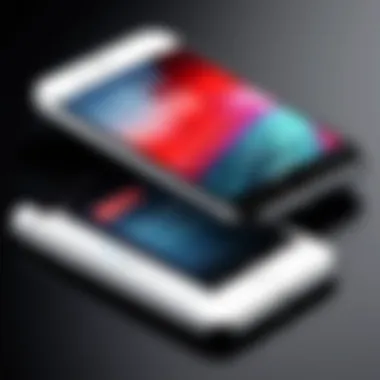Exploring the iPhone Mini Discount Phenomenon


Intro
The evolution of smartphones has led to diverse options for consumers, particularly in recent years with the introduction of devices like the iPhone Mini. This product stands out not just for its compact size, but also for its place within Apple's pricing and marketing strategies. These aspects become even more interesting when discounts and price reductions come into play. Understanding the dynamics of iPhone Mini discounts requires an exploration of its technological underpinnings, consumer behavior, and market landscape.
Through this exploration, we will unravel how these discount phenomena impact purchasing decisions, alternative options for consumers, and the broader implications for the technology market.
Overview of the Technology
The iPhone Mini, introduced as part of Apple’s iPhone 12 lineup, demonstrated Apple’s intention to cater to a segment of users preferring smaller, more manageable smartphones. Featuring a 5.4-inch Super Retina XDR display, it offers vibrant colors and deep blacks, alongside a powerful A14 Bionic chip that ensures smooth performance in demanding tasks.
Key Specifications
- Display: 5.4-inch Super Retina XDR
- Processor: A14 Bionic chip
- Camera: Dual 12MP camera system (Ultra Wide and Wide)
- Battery Life: Up to 15 hours of internet use
- Operating System: iOS 14, upgradable to the latest versions
Unique Selling Points
The iPhone Mini excels not only in size but also in functionality. Its compact form factor retains flagship features, including high-quality cameras and 5G capabilities. Additionally, consumers favor its affordability compared to larger models, encouraging purchases through various discounts. This element often drives consumers to consider the iPhone Mini when exploring budget-friendly smartphone options.
Design and Build Quality
Apple is renowned for designing devices that marry aesthetics and durability. The iPhone Mini is no exception, constructed with high-quality materials that give it a premium feel.
Material Used
The frame uses aerospace-grade aluminum, which enhances both durability and weight management. The front and back panels are made of Ceramic Shield, providing four times better drop performance than previous iPhones, a significant advancement in smartphone engineering.
Ergonomics and Usability
The iPhone Mini's compact dimensions contribute to excellent usability. Users will find it easy to hold and navigate with one hand, a feature increasingly rare in modern smartphones. This ergonomic design resonates well with individuals seeking a functional device without the bulk of larger models.
"The iPhone Mini offers a balance of power and portability, making it an attractive option for those who do not want a large device."
As consumers become more aware of the implications of purchasing discounted devices, understanding the technology and build quality provides crucial insight into their choices. The iPhone Mini serves as an embodiment of a smart alternative in a market filled with larger, more expensive smartphones.
Prelims to iPhone Mini Discounts
The phenomenon of discounts on the iPhone Mini has become a significant aspect of consumer electronics, particularly in the context of Apple products. Understanding these discounts is not just about saving money; it's about recognizing the larger implications of pricing strategies in technology. In this section, we will explore how and why iPhone Mini discounts matter for consumers and the industry as a whole.
One major consideration is the timing and frequency of these discounts. Retailers and Apple often offer promotions that coincide with specific events or product launches, leading consumers to ponder the ideal moment to make a purchase. For instance, discounts can appear during holidays or when newer models are released, creating a perception of urgency among buyers. This reflects a broader market trend where consumers feel the pressure to act quickly on compelling offers.
Furthermore, discounts on the iPhone Mini can significantly impact buyer behavior. Potential consumers might sense a more attractive deal when faced with a reduced price, influencing their purchasing decisions. This is particularly relevant for tech enthusiasts who closely monitor product releases and pricing, making them more receptive to attractive deals.
The implications of these discounts extend beyond individual purchases. They serve to drive competition among retailers, influencing market dynamics. When one retailer offers a discount, others may follow suit to retain customers. This competitive environment can lead to overall lower prices within the market, benefitting consumers.
In addition, it is vital for buyers to understand the limitations of such discounts. Often, the discounted products may have restrictions or come with reduced support, which could pose a challenge later. Thus, consumers must weigh the immediate financial benefits against potential long-term drawbacks.
In summary, the importance of iPhone Mini discounts lies in their influence on individual purchasing decisions and broader market behaviors. The interplay between pricing strategies and consumer psychology creates a complex landscape that discerning buyers must navigate. Understanding this topic enriches our knowledge as consumers in a fast-paced technology-driven world.
Understanding the iPhone Mini
In the context of discounts, understanding the iPhone Mini is crucial for consumers. This iPhone variant stands out in Apple's lineup, combining features and affordability. It caters to tech-savvy individuals who appreciate compact devices without sacrificing performance. The Mini represents an option between the standard models and budget-friendly alternatives, making its pricing dynamics particularly interesting as discounts emerge.
Product Overview
The iPhone Mini is a compact smartphone that shares many features with its larger siblings. It offers a balance of performance, design, and price that appeals to specific user demographics. Launched in a competitive market, it became evident that this product was aimed at those who wanted an Apple device without the bulk.
With its lightweight design and intuitive interface, the Mini holds a significant place in the Apple ecosystem. Users enjoy a full iOS experience, fostering productivity and entertainment. Its smaller size allows for easy handling and portability, a factor critical in a fast-paced world.


Key Specifications
The technical specifications of the iPhone Mini reflect advanced engineering and thoughtful design. Some of the notable aspects include:
- Display: 5.4 inch Super Retina XDR Display, ensuring vibrant colors and sharp images.
- Chip: A14 Bionic chip delivers excellent performance and efficiency, comparable to higher-end models.
- Camera System: Dual-camera system with 12MP ultra-wide and wide lenses offers versatility in photography.
- Battery Life: While compact, it still provides reliable battery performance, supporting daily usage.
These specifications contribute to the Mini's position in the market. Its smaller form factor does not compromise functionality, making it attractive to a wide range of users. Understanding these elements is essential as discounts become available, as they influence perceived value.
The iPhone Mini balances cutting-edge technology with accessibility, appealing to users across various demographics.
The Dynamics of Price Discounts
The dynamics of price discounts play a crucial role in understanding the behavior of both the consumer and the technology market as a whole. The decision to pursue a discount is not merely superficial. It is often driven by various factors, including market positioning, consumer expectations, and competitive strategies. By dissecting these elements, one gains a better grasp of how discounts shape the purchasing landscape for devices like the iPhone Mini.
Understanding these dynamics allows both consumers and retailers to make more informed decisions. For consumers, it can lead to smarter buying strategies, ensuring they get the best value for their money. For retailers, recognizing these dynamics can inform pricing policies that may attract a larger customer base while maintaining profitability.
Market Forces and Pricing Strategies
Market forces influence pricing strategies by determining the perceived value of a product. For the iPhone Mini, Apple's pricing reflects not only its production costs but also market demand and competition.
Several factors contribute to the pricing strategies employed:
- Competitor Pricing: The presence of other smartphone brands affects how Apple prices its devices. For example, if competitors like Samsung reduce their prices, it may prompt Apple to consider similar actions to remain competitive.
- Consumer Demand: Seasonal trends or technological advancements can drive demand, impacting how prices are adjusted. High demand often leads to a more stable or higher price point, while excess supply can result in discounts.
- Brand Positioning: Apple positions itself as a premium brand. Discounts may rarely occur, but when they do, they signal a shift, possibly due to inventory needs or changes in product strategy.
Understanding these strategies provides consumers a lens through which to view discounts. When discounts are available, they may suggest an opportunity to purchase without feeling regret.
Seasonal and Promotional Discounts
Seasonal and promotional discounts are specific pricing strategies that retailers utilize to stimulate sales during certain periods. These discounts often align with holidays or major shopping events, such as Black Friday or back-to-school seasons.
Promotional discounts can also be tied to product launches. When Apple releases a new iPhone model, previous models often see significant discounts to clear out inventory. This approach not only helps Apple manage its stock but also provides an incentive for budget-conscious consumers to purchase devices like the iPhone Mini.
Some key points about these discounts include:
- Timing Matters: Understanding when to buy can save consumers considerable amounts of money. For example, waiting for a holiday promotion could lower the purchase price of an iPhone Mini significantly.
- Limited-Time Offers: These create urgency, prompting consumers to act quickly. A perceived lack of inventory can lead to quicker buying decisions and, often, impulse purchases.
- Bundles and Deals: Retailers may offer discounts as part of a bundle, encouraging consumers to purchase additional products, thus increasing overall sales volume.
In summary, seasonal and promotional discounts not only affect individual buying decisions but also influence broader market trends. Being aware of the cyclical nature of these discounts can aid savvy consumers in maximizing their purchasing power.
Consumer Behavior in the Tech Market
Understanding consumer behavior is crucial for grasping the dynamics of tech markets, especially concerning devices like the iPhone Mini. The decisions people make when buying technology are influenced by multiple factors. These include the perceived value of a product, the impact of discounts, marketing strategies, and overall economic conditions. Tech-savvy individuals and early adopters often follow trends closely. Therefore, their reactions to pricing strategies can significantly influence sales and market positioning.
One primary aspect of consumer behavior in tech is the response to pricing changes. Discounts, especially, create urgency and excitement among potential buyers. They may feel that they are getting a deal, which enhances their likelihood of making a purchase. This is particularly important in technology, where the market is crowded and competitive. Manufacturers often turn to discounts as a way to differentiate their products from others.
Additionally, the timing of discounts can align with various events such as product launches or holiday seasons. Consumers keen on technology often plan their purchases around these periods. They search for the best deals while weighing the benefits of buying immediately against the potential for future discounts. Thus, understanding this behavior can unveil deeper insights into how companies like Apple manage their pricing strategies.
How Discounts Affect Purchasing Decisions
Discounts play a pivotal role in shaping purchasing decisions. When consumers see a discounted price, several psychological triggers may kick in. For example, many view lower prices as an invitation to act quickly. They may think, "This deal won't last long," prompting them to make a decision sooner rather than later.
"Price reductions can stimulate impulsive buying behavior, particularly in the tech sector, where novelty and urgency often intersect."
Moreover, the significance of a discount also depends on an individual's prior expectations. If a consumer believes a product should cost a certain amount, seeing it on sale can validate their preconceptions, further influencing their choice. It is interesting to note that the size of a discount can also sway buyers. Larger discounts often lead to an increased perception of value, encouraging more purchases.
The Psychology Behind Discounts
The psychology surrounding discounts is deeply rooted in principles of consumer behavior. A discount often signifies a potential saving, which many consumers find appealing. This connects to the concept of value perception. When shoppers perceive a product as being of higher value, they become more likely to purchase it, particularly if they feel they are receiving it for less than it is worth.
Furthermore, the idea of social proof comes into play. If many people are purchasing an item on discount, others may follow suit, believing that they, too, should take advantage of what seems like a good offer. Social validation can be a powerful motivator in consumer behavior, especially in technology markets where enthusiasts frequently discuss and recommend products.


In summary, comprehending how consumers interact with discounts is vital for understanding tech market trends. From impulsive decisions due to perceived urgency to the psychological confirmations that discounts provide, these aspects play a crucial role in influencing buying behavior.
Comparing iPhone Mini with Other Models
The iPhone Mini represents a unique offering in Apple's lineup, yet its position becomes clearer when placed alongside other models. Comparing the iPhone Mini with the Standard Models and discussing the value proposition of different iPhone models sheds light on what each device brings to the table. Understanding these comparisons is essential for informed purchasing decisions, especially in a market driven by innovation and consumer preferences.
iPhone Mini vs. Standard Models
When evaluating the iPhone Mini against standard models like the iPhone 13 or iPhone 14, users may notice several key differences that influence their preferences. The most notable distinction is size. The iPhone Mini is compact, designed for those who prefer portability without sacrificing functionality. This personal preference leads to a strong divide among users who prioritize pocketability against those who prefer larger displays for media consumption.
Moreover, another consideration is battery life. While the iPhone Mini is efficient, its smaller size may lead some to conclude that it has limited battery duration compared to its larger counterparts. However, many users find that the performance of the A15 Bionic chip operates seamlessly even under demanding applications, making the size less of a concern than anticipated.
In addition, consumers may consider the price point. The iPhone Mini often comes at a more accessible price, particularly during discount periods. For tech enthusiasts who appreciate high specs without the highest price tag, the iPhone Mini serves as a compelling alternative to standard models.
Value Proposition of iPhone Models
The value proposition of iPhone models is multi-faceted. With the premium price tags associated with Apple's devices, understanding what one gets in return becomes essential. Each model varies not only in price but also in its feature set, which impacts value perception.
The iPhone Mini, for instance, attracts users seeking a balance of high-end performance and affordability. It encapsulates many of the features found in more expensive variants, such as camera quality and processing power. Users who choose the Mini over larger models often cite the benefits of a lighter device, ease of one-handed use, and a more budget-friendly option without significantly sacrificing performance.
When considering value, one must also factor in long-term usability. The iPhone ecosystem supports longevity through software updates, which ensures that even older models can run current applications for several years. Therefore, a consumer choosing the iPhone Mini may find greater appeal in its value retention and continued support from Apple.
"The iPhone Mini is a practical choice, balancing both performance and price, appealing to a wide range of users."
In summary, comparing the iPhone Mini with standard models reveals critical distinctions in size, battery life, and pricing, while shedding light on the overall value proposition across different iPhone models. This analysis serves as an invaluable tool for tech-savvy individuals making purchasing decisions in a competitive market.
Additional Considerations for Buyers
When exploring discounts on the iPhone Mini, there are various important factors potential buyers should consider. These considerations not only enhance the purchasing experience but can also impact the long-term satisfaction with the device. With technology evolving rapidly, understanding the nuances of discounted products becomes crucial for informed decision-making.
Warranty and Support for Discounted Products
Purchasing a discounted iPhone Mini can raise questions about warranty and support. Customers should verify if the discounted device comes with the same warranty as a full-priced model. Apple typically offers a standard warranty for devices, which is usually one year from the purchase date. However, some discounts may come from third-party retailers, and in such cases, the warranty terms might differ.
Here are key points to consider regarding warranty:
- Original Warranty: Ensure the device retains the manufacturer's warranty if bought discounted. This protection covers defects in materials and workmanship, but be cautious; some third-party sellers offer limited or no warranty.
- Extended Warranty Options: Explore if Apple Care or other extended warranty plans are available for purchase. This could provide extra peace of mind if issues arise after the initial warranty expires.
Support options should also be evaluated. Customers should check if the retailer provides customer service in case issues come up. Proper support can make a significant difference in user experience, especially for technologically complex devices.
Possible Limitations of Discount Offers
Discounted iPhone Minis may seem appealing at first, but there can be limitations that buyers should be aware of. These factors can influence whether a discount is genuinely beneficial in the long run.
- Limited Stock: Often, discounts apply to older models that retailers want to clear out. This means availability might be limited, leading to potential frustration if the desired model or color is out of stock.
- Condition of the Device: Some discounted devices might be refurbished or open-box items. Understanding the condition of the device can help in evaluating its reliability and longevity.
- Software Updates: Apple has a history of providing software updates for its devices. However, older models might receive updates for a shorter time than newer models. This can affect security and user experience over time.
- Potential Hidden Costs: Discounts on devices could lead to additional expenses such as higher service fees, costs for accessories, or software not included with the original purchase.
The Role of Retailers in Discounting
In examining the iPhone Mini discount phenomenon, the role of retailers cannot be overlooked. Retailers are crucial in shaping the consumer's shopping experience, particularly in the technology market where price flexibility can lead to significant savings. They often serve as intermediaries between manufacturers like Apple and the buyers, managing the supply chain and affecting pricing strategies. This section explores the influence of third-party retailers and the comparison of online versus in-store discounts, elucidating their impact on the buying process.
Influence of Third-Party Retailers
Third-party retailers play a pivotal role in offering discounts on the iPhone Mini. These retailers include well-known entities like Amazon, Best Buy, and Walmart. Their pricing strategies frequently differ from those of Apple’s official stores, allowing for competitive pricing that can attract budget-conscious consumers.
- Volume Purchasing Power: Retailers benefit from bulk purchasing agreements with Apple, enabling them to pass on savings to consumers.
- Sales Promotions: Seasonal sales events and special promotions by third-party retailers can lead to substantial price reductions.
- Product Bundles: Many retailers offer incentives such as bundle deals which include accessories or service plans, enhancing perceived value.
Retailers also utilize dynamic pricing strategies that allow them to adjust prices in response to competition and market demand. This flexibility often results in discounts that may not be available at Apple stores, providing shoppers with unique opportunities to save.


Online vs. In-Store Discounts
The advent of e-commerce has changed the landscape of retail significantly. Online shopping often presents different discount dynamics compared to traditional brick-and-mortar stores.
Online Discounts
- Usually more aggressive due to lower overhead costs associated with running an online vs. physical store.
- The ease of price comparison platforms enables consumers to find the best deals quickly.
- Exclusive online promotions can lead to increased savings.
In-Store Discounts
- Physical retailers sometimes offer immediate discounts through flash sales which are not advertised online. The tactile experience of handling the device can influence purchasing decisions.
- Opportunity for in-person consultations facilitates informed buying.
- Special offers may include trade-in deals or financing options, benefiting local shoppers directly.
Future Trends in iPhone Pricing
Understanding future trends in iPhone pricing is critical for consumers, analysts, and retailers alike. As the technology landscape evolves, it is essential to know how these changes might affect the purchasing decisions of potential iPhone Mini buyers. Pricing is not just a reflection of market demand; it is influenced by various factors such as production costs, competition, and consumer habits. This section will explore predictions for iPhone Mini discounts and the impact of technological advancements on pricing strategies.
Predictions for iPhone Mini Discounts
The iPhone Mini has gained popularity among users who prefer compact devices with advanced features. With the nature of the tech market reacting quickly to consumer needs, predictions regarding discounts on iPhone Mini can be insightful. A significant trend is the increasing pattern of seasonal discounts. Retailers are likely to leverage events like Black Friday, back-to-school sales, or new product launches to entice customers.
Additionally, as newer models emerge, older generations tend to see price slashes. The iPhone Mini may experience notable discounts shortly after a new flagship release. Analysts also indicate that competition among retailers will intensify, possibly leading to unmissable bundle deals and cash back offers. Therefore, keeping an eye on retailer promotions and market movements gives potential buyers a strategic advantage.
Highlights:
- Seasonal discounts during specific events.
- Price cuts after new models are released.
- Increased competition leading to better deals.
Impact of Technology Advancements on Pricing
Technological advancements have a profound impact on pricing strategies in the smartphone market. As innovations are integrated into new models, older models often receive discounts as part of a natural lifecycle. For instance, the implementation of materials that reduce production costs can help manufacturers offer devices like the iPhone Mini at a lower price point.
Moreover, the rise of online shopping has introduced dynamic pricing models, with prices fluctuating based on demand and inventory levels. Retailers can adjust their prices in real-time, which can directly affect discounts available for devices like the iPhone Mini. Furthermore, advancements in supply chain technology allow manufacturers to optimize inventory management, which also impacts pricing flexibility.
In summary, the intersection of technology and market dynamics will continue to shape how discounts are structured and offered. Consumers should remain vigilant and informed as these factors evolve.
"Technological advancements compel manufacturers to rethink how pricing strategies are designed, often leading to better deals for consumers."
Key Considerations:
- Innovation cycles heavily influence pricing.
- Online shopping enables real-time price adjustments.
- Supply chain efficiencies lead to improved market responses.
Staying informed about these trends can fundamentally change the purchasing landscape for consumers, particularly those seeking the iPhone Mini. By understanding where pricing strategies are heading, buyers can make well-founded decisions about when to purchase.
Ending: Should You Wait for the Discount?
In today's technology market, the decision to delay a purchase in pursuit of discounts can fundamentally influence one's experience as a consumer. This section delves into various factors that individuals must consider when deciding whether to wait for an iPhone Mini discount.
A primary consideration is the timing of your purchase. Discounts on items like the iPhone Mini often align with the release of newer models. For example, when Apple launches its latest iPhone series, retailers may reduce the prices of older models to create space in their inventory. Therefore, if you are not in urgent need of an upgrade, timing can be crucial.
Moreover, it is essential to reflect on your own usage needs. If the current version of the iPhone Mini meets your requirements, waiting for a discount may yield significant savings. However, if you rely on specific features or performance improvements from newer models, waiting might not be worth it.
Additionally, consider the trade-offs of waiting. Discounts may lead to limited availability. For instance, popular retailers might sell out of discounted models quickly, leaving you without the device you intended to purchase.
"Patience in waiting for a discount must be matched with a clear understanding of one’s requirements."
Final Thoughts on Timing Purchases
The decision to purchase an iPhone Mini, especially when discounts arise, is not merely about finding the lowest price. Timing is related to market cycles and personal circumstances. Being aware of seasonal trends in pricing can help. For example, Black Friday or Back-to-School sales often feature substantial discounts on devices. Tracking these periods can maximize your chances of securing a better deal.
Furthermore, understanding your personal usage cycle can prove beneficial. If your current phone performs adequately, waiting might be the best option. If your device is underperforming or issues are increasing, it may be prudent to act rather than hope for future savings.
Balancing Short-Term Savings with Long-Term Value
When evaluating discounts vs. value, short-term savings should not overshadow long-term benefits. There is often a balance that customers must strike between saving money now versus enjoying the latest technology. Discounts are attractive, but potential limitations or fewer features in older models should be taken into account.
Moreover, warranties and support can also come into play. Older models may have restricted support, which could become problematic long-term. Evaluate what exactly you’re getting with a discounted product. Will it retain value over time? Or will it quickly be overshadowed by newer advances?





